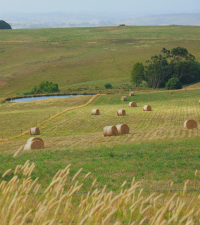
HowGood recently announced the addition of our end-to-end FLAG emissions reduction tool built specifically for the food industry.
Integrated into Latis, HowGood’s SaaS sustainability intelligence platform, our FLAG tool’s dynamic nature enables sustainability teams to be agile in accounting for change and assessing progress on an ongoing basis.
Previously, given the recent shift in granular reporting requirements, food companies have not had a systematic way to determine how much of an impact various initiatives or efforts would have on reducing FLAG emissions and driving progress toward their target. This meant that once companies set their target, sustainability teams would largely be making assumptions about how to reduce emissions and where to invest efforts.
HowGood’s FLAG dashboard empowers food companies to measure and break out FLAG emissions across their portfolio and find paths to reduction.
HowGood’s recent webinar, Getting Ready for SBTi FLAG: How food companies can meet carbon reduction goals, delved into the specifics of FLAG Guidance and the action steps companies can take now.
In this article, we summarize the critical aspects of target-setting and reporting timelines, as well as resources available through HowGood’s Latis platform.
Carbon Accounting for Food Companies: Setting the stage
The driving force behind carbon accounting, and the initiatives by the Greenhouse Gas (GHG) Protocol and Science Based Targets Initiative (SBTi), specifically, is to empower corporations to lead the decarbonization of the global economy.
The goal is to limit global warming to 1.5°C above pre-industrial levels by 2050. Why 1.5 degrees? Climate and policy specialists modeled the impacts of varying degrees of warming on the planet, humans, agriculture and biodiversity. They determined that 1.5°C is the best case scenario, with dire consequences appearing in models with an increase of two, four or greater degrees in temperature rise.
The land sector, also referred to as FLAG (forest, land and agriculture) accounts for 22% of global emissions, but has been identified as having the potential to deliver 30% of emissions reductions by 2050.
Navigating the Carbon Accounting Landscape
Globally, there are a collection of governing bodies and standards that work in concert when it comes to carbon accounting and reporting. Although we’re still at the stage where carbon accounting is voluntary, various pieces of legislation are in development around the world that would make it mandatory in the near future.
The first step in this process involves measuring and accounting for your GHG emissions, also known as your GHG inventory. The GHG Protocol is the global accounting body that sets the standards for how to measure and account for GHG emissions.
HowGood’s carbon accounting in the Latis platform has been built according to two of the GHG Protocol standards:
- The Product Standard, which accounts for the GHG emissions of a product throughout its lifecycle.
- The Corporate Scope 3 Standard, which defines how Scope 3 emissions (emissions generated throughout the supply chain, outside of a company’s direct control), should be accounted for and reported.
Note that these two standards are not specific to the land sector (they’re not food or agriculture-specific). The next step in this accounting and reporting process is where the Science Based Targets Initiative (SBTi) comes in.
Science Based Targets and the Food Industry
SBTi is the global target-setting body which provides the framework to set sustainability goals aligned with climate science. The introduction of FLAG Guidance now provides the specific guidelines, which previously didn’t exist, around land-based targets within SBTi.
FLAG Guidance is relevant mainly for large enterprises that have set or will set SBTi targets. Small and medium enterprises that set SBTi targets are not yet required to set FLAG targets, although there is an accelerated pathway for those who wish to use them.
SBTi’s FLAG Guidance was released in September 2022. It enables companies to make commitments and set targets for the reduction of land sector emissions, and is aligned to the LSR’s three categories of emissions and removals. SBTi recommends that companies begin now by calculating baseline emissions in line with the current guidance. You can then set your target and begin creating a strategy and timeline to reach it.
FLAG and Land Sector Emissions (LSR)
As mentioned above, land sector emissions contribute an estimated 22% of global emissions. This poses both a significant responsibility and also a huge opportunity for companies heavily reliant on the land sector, such as those in the food industry.
To grasp the full picture, consider the contributions of other major industries to global emissions:
- Transport: 15%
- Buildings: 6%
- Energy systems: 33%
- General industry: 24%
Emissions for these other industries are somewhat easier to track because the data exists within human-created and controlled systems. Unlike these sectors, the land sector’s emissions are challenging to quantify accurately due to nature’s complex, interconnected systems.
However, nature utilizes the power of plants, soil and biomass in removing and storing carbon and technological solutions are not yet able to match that efficiency. Harnessing the power of nature-based solutions becomes possible when you have access to deep expertise in mapping nature-based systems. To do this, you need:
- Access to granular emissions factors, rather than global averages
- A consistent means of assessing your FLAG emissions, using the same system boundaries and functional units and methodology across your whole portfolio
- The ability to track raw materials throughout all stages of the supply chain, from crop, to processed ingredients, products, categories, brands and portfolios
- Capacity to do all of this quickly and easily using dynamic, agile tools

Requirements for Setting a FLAG Target
FLAG is the land sector-specific initiative of the SBTi to decarbonize the global economy. Understanding the requirements is crucial for companies striving to align with SBTi’s land-sector-specific objectives. Here’s a concise breakdown of what setting a FLAG target entails:
FLAG Target Requirements
- Set near-term targets: Set science-based targets for emissions reduction within a 5-10 year timeframe, in line with the objective to limit global warming to 1.5°C.
- Account for removals in near-term targets: Examples could involve improving forest management practices or enhancing soil carbon sequestration on operational lands.
- Long-term targets: For companies within FLAG sectors, you need to commit to a minimum of 72% emissions reduction by 2050.
- Zero deforestation by 2025: Companies must eliminate deforestation from their supply chains by 2025. With limited time left to achieve this, tools like those offered by HowGood can provide instant insights into your deforestation risks, allowing you to take immediate action.
- Set targets for fossil emissions: FLAG targets are not standalone. Companies are required to set overall science-based targets, which should include specific goals for reducing fossil fuel emissions.
The SBTi has developed an online tool to streamline the process of setting your FLAG targets, making it straightforward and standardized:
- You enter your baseline year, which can be no earlier than 2015.
- You enter your target year, which can be no later than 2027.
- You then enter your baseline emissions for the identified base year, which HowGood can help you calculate. Our extensive database of granular emission factors for more than 33,000 ingredients means you can set a highly accurate baseline. Having data at this granular level will make your emissions reduction goals much more achievable.
The SBTi tool then tells you, based on your commodities and sourcing regions, how much you need to reduce your emissions in order to align with a scenario of 1.5 or 2 degrees of warming by 2050.
Timeline for Setting FLAG Targets
The timeline for setting FLAG Targets is contingent upon when your overall SBTi targets are or will be established:
- For SBTi Targets Set Before April 30, 2023: FLAG targets must be defined within six months following the finalization of the LSR Guidance in mid-2024.
- For SBTi Targets Set After April 30, 2023: Both SBTi and FLAG targets should be submitted simultaneously.
Regardless of your current stage in the FLAG journey—whether you’ve already set your targets or are planning to—it’s imperative to prepare for and align with these timeline requirements.
Once you’ve set a baseline and reported emissions, you need a strategy and timeline to reduce those emissions. You also need a process to measure impact and report progress each year, both to global bodies and your company’s internal and external stakeholders.
HowGood’s Latis platform meets food companies’ needs to measure, manage, reduce, and report on carbon footprints. With 17 years of global food supply chain research, consolidated from over 600 accredited data sources and certifications, Latis offers the granularity of data required by the GHG Protocol product standard, with reporting fully in alignment with corporate carbon accounting standards and frameworks such as CDP and GRI.
Trusted by enterprise food brands and retailers across the globe, Latis provides a reliable data solution that saves time and allows for dynamic innovation and scenario planning so that you can hit your targets.




.png)
